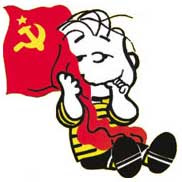
Ernesto Guevara de la Serna (June 14,[1] 1928 – October 9, 1967), commonly known as Che Guevara, El Che or just Che was an Argentine-born Marxist revolutionary, political figure, and leader of Cuban and internationalist guerrillas.
As a young man studying medicine, Guevara travelled throughout South America, bringing him into direct contact with the impoverished conditions in which many people lived. His experiences and observations during these trips led him to the conclusion that the region's socio-economic inequalities could only be remedied by socialism through revolution, prompting him to intensify his study of Marxism and travel to Guatemala to learn about the reforms being implemented there by President Jacobo Arbenz Guzmán.
While in Mexico in 1956, Guevara joined Fidel Castro's revolutionary 26th of July Movement, which seized power from the regime of the dictator[2] General Fulgencio Batista in Cuba in 1959. In the months after the success of the revolution, Guevara was assigned the role of "supreme prosecutor",[citation needed] overseeing the trials and executions of hundreds of suspected war criminals from the previous regime.[3] After serving in various important posts in the new government and writing a number of articles and books on the theory and practice of guerrilla warfare, Guevara left Cuba in 1965 with the intention of fomenting revolutions first in Congo-Kinshasa, and then in Bolivia, where he was captured in a military operation supported by the CIA and the U.S. Army Special Forces.[4] Guevara was summarily executed by the Bolivian Army in the town of La Higuera near Vallegrande on October 9, 1967.[5]
After his death, Guevara became an icon of socialist revolutionary movements and a cultural icon worldwide. An Alberto Korda photo of him (shown) has received wide distribution and modification, appearing on t-shirts, protest banners, and in many other formats. The Maryland Institute College of Art called this picture "the most famous photograph in the world and a symbol of the 20th century."[6]
As a young man studying medicine, Guevara travelled throughout South America, bringing him into direct contact with the impoverished conditions in which many people lived. His experiences and observations during these trips led him to the conclusion that the region's socio-economic inequalities could only be remedied by socialism through revolution, prompting him to intensify his study of Marxism and travel to Guatemala to learn about the reforms being implemented there by President Jacobo Arbenz Guzmán.
While in Mexico in 1956, Guevara joined Fidel Castro's revolutionary 26th of July Movement, which seized power from the regime of the dictator[2] General Fulgencio Batista in Cuba in 1959. In the months after the success of the revolution, Guevara was assigned the role of "supreme prosecutor",[citation needed] overseeing the trials and executions of hundreds of suspected war criminals from the previous regime.[3] After serving in various important posts in the new government and writing a number of articles and books on the theory and practice of guerrilla warfare, Guevara left Cuba in 1965 with the intention of fomenting revolutions first in Congo-Kinshasa, and then in Bolivia, where he was captured in a military operation supported by the CIA and the U.S. Army Special Forces.[4] Guevara was summarily executed by the Bolivian Army in the town of La Higuera near Vallegrande on October 9, 1967.[5]
After his death, Guevara became an icon of socialist revolutionary movements and a cultural icon worldwide. An Alberto Korda photo of him (shown) has received wide distribution and modification, appearing on t-shirts, protest banners, and in many other formats. The Maryland Institute College of Art called this picture "the most famous photograph in the world and a symbol of the 20th century."[6]
READ MORE: http://en.wikipedia.org/wiki/Che_guevara
 CHE AND FIDEL CASTRO.
CHE AND FIDEL CASTRO. 
























